Click on images to enlarge
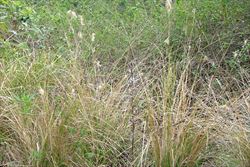
infestation (Photo: Sheldon Navie)
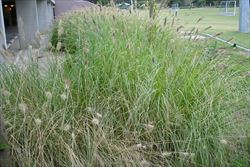
mass garden planting (Photo: Sheldon Navie)
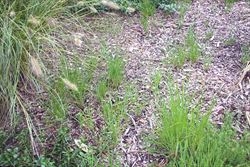
self-seeding garden planting (Photo: Sheldon Navie)
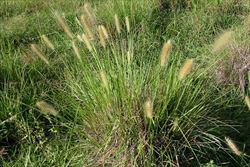
habit during summer (Photo: Sheldon Navie)
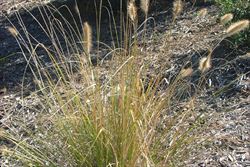
habit during winter (Photo: Sheldon Navie)
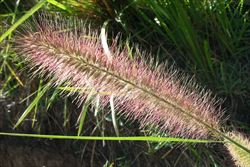
seed-head (Photo: Sheldon Navie)
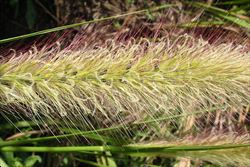
close-up of flower spikelets with long stigmas (Photo: Sheldon Navie)
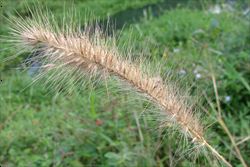
mature seed-head (Photo: Sheldon Navie)
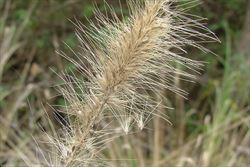
close-up of mature flower spikelets (Photo: Sheldon Navie)
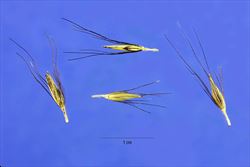
close-up of seeds (Photo: Steve Hurst at USDA PLANTS Database)

young plants (Photo: Sheldon Navie)
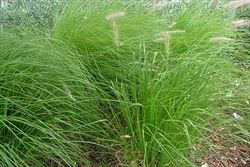
comparison of swamp foxtail (Pennisetum alopecuroides), with broader leaves and stiff upright seed-heads in the foreground, and fountain grass (Pennisetum setaceum), with narrower leaves and drooping seed-heads in the background (Photo: Sheldon Navie)
Scientific Name
Cenchrus purpurascens Thunb.
Synonyms
Pennisetum alopecuriodes (L.) Spreng.
Panicum alopecuroides L.
Pennisetum compressum R. Br.
Family
Gramineae (South Australia)
Poaceae (Queensland, New South Wales, the ACT,
Victoria, Tasmania, Western Australia and the Northern
Territory)
Common Names
Australian fountain grass, Chinese fountain grass, Chinese fountaingrass, Chinese pennisetum, foxtail fountain grass, fountain grass, fountaingrass, perennial fountain grass, swamp fox tail grass, swamp foxtail, swamp foxtail grass, swamp foxtail-grass
Origin
Native to China, Japan, south-eastern Asia (i.e. Myanmar, Indonesia and the Philippines) and eastern India (i.e. Assam). Sometimes also regarded as being native to large parts of eastern Australia (i.e. eastern Queensland, eastern and southern New South Wales and the ACT).
Naturalised Distribution
It is certainly naturalised in southern and eastern Victoria and sparingly naturalised in Tasmania. While this species has often been considered native to large parts of eastern Australia (i.e. Queensland, eastern and southern New South Wales and the ACT), it is now uncertain whether this is the case. Plants that have recently become popular in cultivation are probably also derived from an introduced form of this species.
Habitat
This species prefers sandy soils and is a weed of rangelands, grasslands, open woodlands, floodplains, roadsides, disturbed sites, waste areas and gardens in semi-arid, tropical, sub-tropical and warmer temperate regions.
Habit
A tufted grass usually growing 0.3-1 m tall, but occasionally reaching up to 1.5 m or more in height. It has a tough, long-lived (i.e. perennial), rootstock and varies from being mostly upright (i.e. erect or ascending) to spreading (i.e. decumbent). It sometimes also produces creeping stems that root at the joints (i.e. stolons).
Distinguishing Features
-
an upright to spreading tufted grass growing 0.3-1.5 m tall.
-
its very elongated leaves (3-37 cm long and 2-13 mm wide) are flat and sometimes hairy towards the base.
-
where the leaf sheath meets the leaf blade there is a small line of tiny hairs 0.2-2 mm long.
-
its seed-heads (2.5-15 cm long and 1-2.5 cm wide) are spike-like, very bristly and purplish, reddish or greyish in colour.
-
its seeds are shed in a soft, bristly, burr-like structure, which is pale brown or straw-coloured.
Stems and Leaves
The wiry stems (1-4 mm thick) often produce roots from their lower joints (i.e. nodes) and may be branched above the base of the plant. They are mostly hairless (i.e. glabrous), though the stem joints (i.e. culm nodes) may be hairless or hairy (i.e. glabrous or pubescent).
The leaves are made up of a sheath, which partially encloses the stem, and a spreading leaf blade. The leaf blades (3-37 cm long and 2-13 mm wide) are very elongated (i.e. linear) in shape, usually flat, and have a pointed tip (i.e. acute apex). They are green, bluish-green or greyish-green in colour and mostly hairless (i.e. glabrous) or sometimes hairy (i.e. pubescent) towards the base. Where the leaf sheath meets the leaf blade there is a small line of tiny hairs (i.e. ciliate ligule) 0.2-2 mm long. The leaf sheaths are smooth and hairless (i.e. glabrous) or slightly rough in texture (i.e. scaberulous).
Flowers and Fruit
The seed-heads (2.5-15 cm long and 1-2.5 cm wide) are spike-like (i.e. a spiciform panicle) and held upright (i.e. erect) or nodding. They are moderately dense with numerous bristles and are purplish, reddish or greyish in colour. These seed-heads consist of numerous very short side-braches (i.e. fascicles) along a slightly zig-zagging stalk, with each tiny branch having 1-4 flower spikelets. Below the flower spikelets there is a cluster of soft bristles of various lengths (up to 16 mm long), with one bristle being significantly longer than the others. These bristles have tiny forward-pointing (i.e antrorse) barbs that give them an adhesive quality. The flower spikelets (2.5-5 mm long and 1-2 mm wide) are elongated (i.e. lanceolate) to egg-shaped in outline (i.e. ovate) with pointed tips (i.e. acute apices). They are hairless (i.e. glabrous) and consist of a pair of glumes (i.e. 2-3.5 mm long) and a pair of tiny flowers (i.e. florets). The lower floret is usually male or sterile, while the upper one has both male and female parts (i.e. it is bisexual). Each floret has two bracts (i.e. a palea and a lemma), the male ones have three stamens, and the bisexual ones also have an ovary topped with two feathery stigmas. Flowering occurs throughout most of the year (i.e. mainly from February to October), usually after rain.
The seeds are shed in a soft burr-like structure, which consists of the cluster of bristles and one or more mature spikelets (i.e. the entire fascicle). Hence, each 'burr' can contain more than one seed. When mature these 'burrs' turn pale brown or straw-coloured. The dark brown seeds (i.e. grains or caryopses) are broadly oblong in shape and somewhat flattened (1-1.3 mm long).
Reproduction and Dispersal
This species reproduces mainly by seed. The seeds are dispersed in soft burr-like structures and are easily blown about by the wind. They may also float on water and readily become attached to livestock, other animals, clothing, machinery and other vehicles. Long distance dispersal can also occur in contaminated agricultural produce (e.g. pasture seeds, gain and wool).
Legislation
This species is not declared under any state or local government legislation in the region.
Management
As this species is not a declared plant, its control is not required and there are no restrictions on its sale or cultivation. However, it is a serious environmental weed and should be managed in sensitive bushland and conservation areas.
Similar Species
Buffel grass (Pennisetum ciliare) is very similar to white buffel grass (Pennisetum pennisetiforme) and relatively similar to Mossman River grass (Cenchrus echinatus), Birdwood grass (Pennisetum setigerum) and the spiny burrgrasses (Cenchrus incertus and Cenchrus longispinus). These species can be distinguished by the following differences:
- buffel grass (Pennisetum ciliare) has seed-heads that do not
produce spiny 'burrs'. Instead, its seed-heads bear flower spikelet clusters
that have numerous long bristles with tiny forward-pointing (i.e.
antrorse) barbs. These bristles are free from the base and are not joined
together for any noticeable distance.
- white buffel grass (Pennisetum pennisetiforme) has seed-heads that
do not produce spiny 'burrs'. Instead, its seed-heads bear flower spikelet
clusters that have numerous long bristles with tiny forward-pointing
(i.e. antrorse) barbs. These bristles are fused at the base (i.e. connate) and
are joined together for a short distance (1-3 mm).
- Mossman River grass (Cenchrus echinatus) has
seed-heads that produce spiny 'burrs'. These 'burrs' are stalkless (i.e.
sessile), have one row of larger flattened spines, and numerous smaller hairy
bristles at their base. These spines are fused at the base (i.e. connate)
and are joined together for some distance (2-5 mm).
- Birdwood grass (Pennisetum setigerum) has seed-heads that produce
somewhat spiny 'burrs'. These 'burrs' have one row of larger flattened
spiny bristles, and numerous smaller hairy bristles at their base. The
flattened spiny bristles are fused at the base (i.e. connate) and
are joined together for a short distance (1-3 mm).
- spiny burrgrass (Cenchrus incertus) has seed-heads that produce spiny 'burrs'. These 'burrs' are
almost stalkless (i.e. sub-sessile), have several rows of larger flattened spines
(usually with only 8-25 spines in total), and numerous smaller
hairy bristles at their base. These spines are fused at the base (i.e.
connate) and are joined together for some distance (2-7 mm).
- spiny burrgrass (Cenchrus longispinus) has seed-heads that produce spiny 'burrs'. These 'burrs' are shortly stalked (i.e. pedicellate), have several rows of larger flattened spines (usually with 40-70 spines in total), and numerous smaller hairy bristles at their base. These spines are fused at the base (i.e. connate) and are joined together for some distance (2-7 mm).
It can also be confused with several other native and introduced species of grasses (i.e. Cenchrus spp. and Pennisetum spp.). To distinguish between all of these a specialist text should therefore be consulted (e.g. Ausgrass: an interactive key to Australian grasses).
Notes
Swamp foxtail (Cenchrus purpurascens) is sometimes regarded as an environmental weed in Queensland and New South Wales. It is also regarded as an environmental weed in Victoria, and as a potential environmental weed in Tasmania and Western Australia. It has recently become popular as an ornamental grass that is often planted in gardens and amenity areas. As the common name suggests, swamp foxtail (Cenchrus purpurascens) generally invades moist sites such as river flats, swamps, marshes and low-lying pastures.
This fact sheet has been updated thanks to the sponsorship of Sunshine Coast Council.

